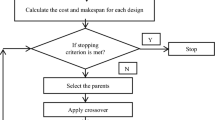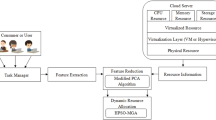Abstract
Resource management system helps the enterprises to coordinate the IT resources in connection to the action performed by the key players such as cloud customers and service providers. Present day cloud resource and service providers use a heterogeneous allocation strategy for resources allocation across various geographical locations. Further, these allocations are completely in need of secure transactions, effective scheduling and dynamic resource allocation strategies. To overcome the above mentioned issues, this paper proposes a novel resource allocation framework for the cloud service providers to schedule and effective resource allocation. The key idea of the proposed resource allocation scheme is to utilize Non dominated Sorting Genetic Algorithm (NSGA-III) to effectively allocate resources. Furthermore, the proposed NSGA-III is modified to support any interim data sources (any middle wares). The proposed model is experimentally validated in the test bed with multi-node Hadoop cluster. The experimental results confirm that the proposed model outperforms the existing state of the art models such as Lion optimization, Traditional ACO and Particle based Kernel function algorithms with more than 95% in accuracy.








Similar content being viewed by others
References
Lin H, et al (2014) Hybridizing infeasibility driven and constrained-domination principle with MOEA/D for constrained multiobjective evolutionary optimization. In: Cheng SM, Day MY (eds) Technologies and applications of artificial intelligence, TAAI 2014. lecture notes in computer science, vol 8916. Springer, Cham.
Sun Y, Lin F, Haitao Xu (2018) Multi-objective optimization of resource scheduling in Fog computing using an improved NSGA-II. Wirel Pers Commun 102(2):1369–1385
B Tan, H Ma, Y Mei (2017) A NSGA-II-based approach for service resource allocation in Cloud. In: 2017 IEEE congress on evolutionary computation (CEC). IEEE, San Sebastian, pp 2574–2581, 5–8 June 2017
Mazumdar S, Pranzo M (2017) Power efficient server consolidation for cloud data center. Fut Gen Comput Syst 70:4–16
Wang D, Yang Y, Mi Z (2015) A genetic-based approach to web service composition in geo-distributed cloud environment. Comput Electr Eng 43:129–141
Al Faruque MA, Vatanparvar K (2016) Energy management-as-a-service over fog computing platform. IEEE Internet Things J 3(2):161–169
Deng R, Lu R, Lai C, et al. (2015) Towards power consumption-delay tradeoff by workload allocation in cloud-fog computing. In: 2015 IEEE International Conference on Communications (ICC). IEEE, London, UK, pp 3909–3914, 8–12 June 2015
Joshan AJ, Sibi Chakkaravarthy S, Vasuhi S, Vaidehi V (2019) Trajectory based abnormal event detection in video traffic surveillance using general potential data field with spectral clustering. Multim Tools Appl 2019:1–27
Arivudainambi D, Varun Kumar KA, Sibi Chakkaravarthy S (2019) LION IDS: a meta-heuristic approach to detect DDoS attacks against software defined networks, neural computing and applications, vol. 31, issue 5, May 2019, Springer. https://doi.org/10.1007/s00521-018-3383-7
Maenhaut P, Moens H, Volckaert B, Ongenae V, Turck FD (2017) Resource allocation in the cloud: from simulation to experimental validation. In: 2017 IEEE 10th international conference on cloud computing (CLOUD). IEEE, Honolulu, CA, 2017, pp 701–704, 25–30 June 2017
Wang X, Wang X, Che H, Li K, Huang M, Gao C (2015) An intelligent economic approach for dynamic resource allocation in cloud services. In: IEEE transactions on cloud computing, vol. 3, no. 3. IEEE, pp 275–289, 1 July–Sept. 2015. https://doi.org/10.1109/TCC.2015.2415776
Xu X, Dou W, Zhang X, Chen J (2016) EnReal: an energy-aware resource allocation method for scientific workflow executions in cloud environment. In: IEEE transactions on cloud computing, vol. 4, no. 2, pp. 166–179, 1 April–June 2016.
Khasnabish JN, Mithani MF, Rao S (2017) Tier-centric resource allocation in multi-tier cloud systems. In: IEEE transactions on cloud computing, vol. 5, no. 3.IEEE, pp 576–589, 1 July-Sept. 2017.
Author information
Authors and Affiliations
Corresponding author
Additional information
Publisher's Note
Springer Nature remains neutral with regard to jurisdictional claims in published maps and institutional affiliations.
Rights and permissions
About this article
Cite this article
Miriam, A.J., Saminathan, R. & Chakaravarthi, S. Non-dominated Sorting Genetic Algorithm (NSGA-III) for effective resource allocation in cloud. Evol. Intel. 14, 759–765 (2021). https://doi.org/10.1007/s12065-020-00436-2
Received:
Revised:
Accepted:
Published:
Issue Date:
DOI: https://doi.org/10.1007/s12065-020-00436-2




